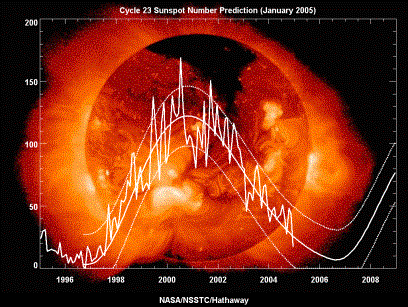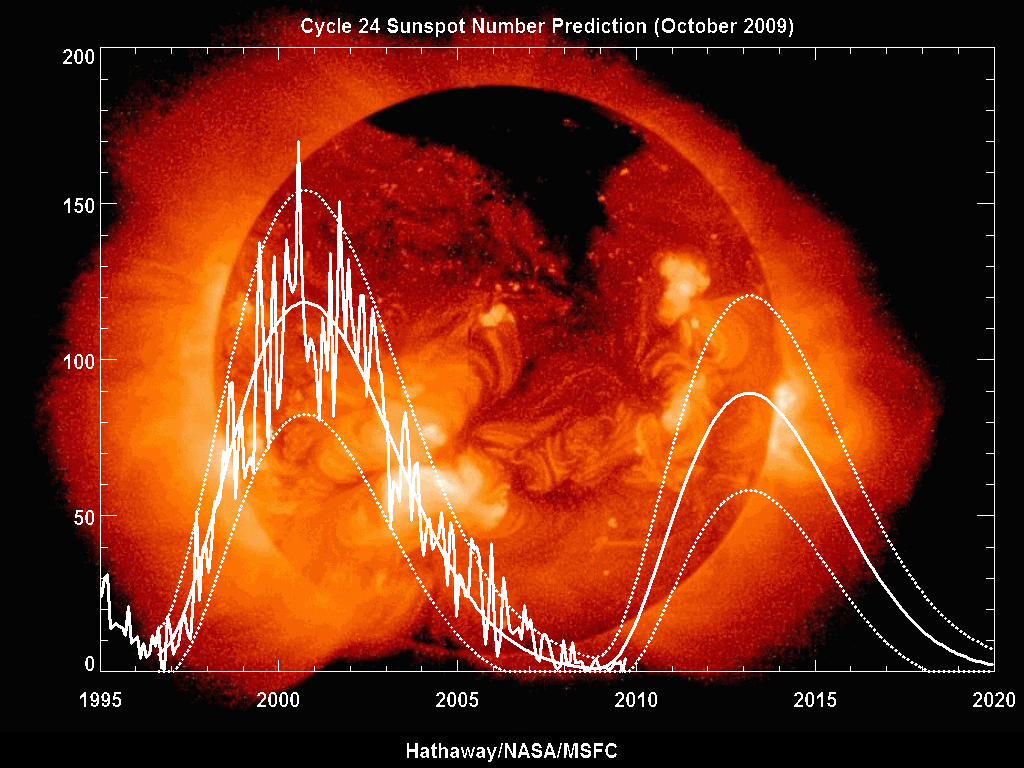Sun Spots
Original Version
For Printing
|
Sun Spots are dark anomalies that appear on the surface of the Sun.
Scientists have concluded these anomalies are the result of the Sun's magnetic
field.
The internal core mechanics of the Sun are not fully understood and it is here
where events leading to the occurrence of sunspots take place. Current
explanations, related to the internal processes of the Sun are missing a key
controlling factor, the dampening effect of the heavy elements on the fusion
reaction rate and in the case of iron - nickel its magnetic properties. |
|

|
The 11-year cycle for our Sun's sunspots is a balance of
three main factors that eventually lead to their occurrence. First, is the
homogeneity of the dispersed heavy elements infused with hydrogen and the other light
elements, which is all moving about the stellar core. Second, is the stir caused by internal
core rotational momentum due to pressure inequalities in various core zones and
their
attractions from external gravitational sources and overshoot, which controls core rotation. Third, is the energy absorption
and dissipation rate of heat sub atomic particles within the fringe heavy
elements along the outer edge of the fusion activity zone of its core govern by
the incoming gravitational subatomic particle flow, causing
their movement. The first and second factors, homogeneity of the light and heavy
elements and core rotational mixing are the balancing determinates of heat
production and molecular activity affecting the fringe heavy elements. In the
short time period of any stellar cycle of expansion and compression,
gravitational subatomic flow, which compresses the core is stable, but the
density of this core does change. Any shift
in this balance would slow or accelerate the present 11-year cycle of movement
from peak to peak.
The cycle begins as the heavy elements on the outer edge of
the fusion activity core zone, absorbs energy to the point where it initiates a
migration of the affected matter away from the central stellar core. This allows a
slight increase in the fusion and molecular motion rate within the core as these
control factors, the heavy elements move out towards the surface of the Sun. An energy surge ensues and its
effects cascade on the heavy elements initially moving them at an exponential rate
from the stellar core. Its dense
structure of these heavy elements readily absorbs the increased radiation of heat sub atomic particles.
Hence, many self-contained bubbles of heavy elements affected by heat and molecular
motion expand to the point where its density rapidly increases. Now lighter than
the surrounding mass pushed with momentum, it rises away from the core amid the denser hydrogen and
helium elements. It is the lighter density of the heavy elements when heated to
a higher temperature that makes it float in an environment of many light
elements at a lower temperature, which has a relative denser structure holding
the heat subatomic particles. Once out
of the active zone of the core, the heavy elements slowly dissipate their heat
and molecular motion into the surrounding mass, then coalesce into a dense
sphere of heavy elements and sink back towards the core. It is there close
approach to the stellar surface that is responsible for the appearance of
sunspots. Upon entering the
fusion zone again, many sub-processes recycle and initiates a new sequence of
events. This sinking process of
the heavy elements affects the core in three prominent ways. First, by shutting
down the localized fusion process in close proximity of the heavy element
spheres. Forcing light elements on the fringe deeper into the core and finally a
smaller containment area and greater compression. Thus the expansion phase due
to new reaction cycle back towards expansion.
The scientific
details that supports the foundation of 11-year cycle
of the occurrence of sun spots is related to the Sun's core. Our Sun's
fusion process oscillates, as the compression area
for reaction contracts and expands. As the heavy elements are removed from the
core by centrifugal force, the fusion rate increases, thus an active stellar
core.
As the core dissipates energy into the interstellar medium, the stellar mass
shrinks and gravitational
subatomic particle flow increases compression
and the fusion rate. The total cycle between peak, ebb and peak in our Sun is
normally 11 years unless acted upon by an outside force. During the period peak
activity within the core, heavy element pockets are sporadically ejected from
the core. The centrifugal force and core energy moves these pockets towards the surface while
bending the direction of flow towards a path that is parallel to the equatorial
plane. This is why most sun spots appear 35 degrees above or below the
equatorial plane.
The heavy elements
primarily composed of nickel-iron are suspended in pockets just below the stellar surface
at a point of
equilibrium with momentum preserved from core ejection, a boost from convection and
centrifugal force outwards. The counter, gravitational subatomic particles
flowing
towards the core. Thus the flow of energy is deflected around the ejected heavy
element anomaly and it is
disturbance in flow of heat subatomic particles that causes the sun spots.
As flow of heat subatomic particles flow around
the obstruction the principles of particle movement take precedence. The center of the spots have less
energy projected to this area. Why, as particle streams flows around an
obstruction, it spreads then converges. It is the high density convergence upon
a central low density point to which particle movement flows towards that
temporary void. Creating a temporary surface dimple effect on the surface of the
object in question. The spikes are form from intensity of flow where radial
streams are a compromise of the absence of heat sub atomic particles and the
surrounding mass, thus a series of low activity spikes of alternating and normal
surface mass surrounding the basic sun spot. The mass differential between the heavy element
pocket and the lighter hydrogen-helium surface initiates a rotation of the
pocket reinforcing the inherited spin when ejected from the core. The subtleties
of the spin creates pinwheel affect about the individual sun spot on the surface texture of
the Sun.
There is confusion within the scientific
community that sun spots are caused by
the Sun' magnetic field, when in fact it is the sunspots that is the termination
point for the source magnetic subatomic particle flowing from the Sun's magnetic
north pole. This is caused by the underlying heavy element
pockets that attracts and blocks the normal heat
convection flows towards the surface of the Sun. The iron-nickel composition of the
heavy elements and its polarized structure provides magnetic subatomic
particles an alternate flow, diverted from the primary field heat towards the
Sun's south pole. They flow along pathway of least
resistance back towards the core. This why charged solar particle ejections
curve back towards these magnetic anomalies.
So why has the
solar color of the Sun moved from pre 2002 of yellow to white, yet with this
increased activity, sunspots and flares have decreased?
Still not revealed
in Dec. 2009 to the general public from official sources, the
12th planet being highly magnetic has moved up
into the ecliptic plane where it presently resides. Where alignment oscillates with the Sun's
magnetic field as a compromise resulting in a side by side, thus there is a compression of particle flows about and
within both objects due to close proximity. To a magnetic pole attraction, which
tips the12th planets pole, ultimately affecting Earth.
As the magnetic related iron-nickel pockets are squeezed
towards the core it pushes new hydrogen fuel within the stellar mass into the compression zone, thus
their is
increased activity and greater turmoil. Usually pockets of these heavy
elements are ejected from the stellar core where they temporarily float towards
the stellar sub-surface creating
blemishes, sun spots. The introduction of the 12th planet and its magnetic field
within the solar system has suppressed expansion of the Sun's heavy elements
that are magnetically
aligned the core. This pressure pushed the heavy elements on the
fringe closer to the core, but also forcing in new sources of hydrogen.
This resulted
an increased reaction rate, but the added magnetic field does not allow the
heavy elements to drift beyond the outer core. Creating a brighter
whiter, larger Sun than what was observed by all pre 2002. The suppression
of the heavy elements drifting in the sub surface has decreased significantly as
these anomalies do not achieve
the ejection velocities due to the intense push back of the outside magnetic
field. Unexplained, until now is absence or low level of sunspots when the cycle should more than half
way towards the established scientific peak in 2012.
This process going on in
the core with other adjustments to be commented on at a later will lead to a
warning for all of mankind as the surface of the Sun explodes sending a super
flare towards Earth that rolls back its atmosphere like a scroll and shakes the
Earth where the powerful will cower in fear. Details will come in a new paper,
The Warning.
Consider this when
Examining the Magnetic Properties of a Stellar Object
Hydrogen and helium
are poor candidates to be considered as producers of a magnetic field in a solar
object. The internal magnetic flow of the Sun is interrupted as sun spots
diverts the primary source of magnetic subatomic particle flow, the magnetic
north pole. It is this interaction between the rogue
pockets of heavy iron elements ejected to where they temporarily suspend within the stellar subsurface
and primary heavy iron element located in the Sun's core. These massive clumps
tends to destabilize and deviate the primary flow of magnetic particles as they
are emitted from the north to reenter at the south magnetic poles of the Sun.
Thus producing eddies and secondary flows outside the established magnetic field
lines as they travel.
The 2005
predictions are falling short of the current sunspot activity.
So in 2009 the prediction of current sunspot
activity was revised and shifted out without explanation
Sunspot Cycle Trends of the Last Hundred
Years
Take note: the peaks and valleys may vary, buy the 11 year
cycle remains intact, until the 1st decade of the 21st century
This graph shows the number of sunspots counted each year for
several decades. Notice how consistent the sunspot count rises and falls in an 11-year
cycle.
Windows to the Universe original artwork by Randy
Russell.
Source:
http://www.windows.ucar.edu/tour/link=/sun/images/sunspot_cycle_graph_big_gif_image.html
So how has NASA's predictions changed during this decade
without an explanation to an established pattern over centuries?
NASA has offered
no explanation for the current deviations in the present sun spot cycle, but as
an official mouth piece of the scientific community on Earth, their assessment
has not been questioned.
Link:
nasapredict.htm
All Rights Reserved: © Copyright 2001,
2009
Mankind's
Explanation of Sun Spots



